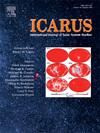Low dispersion spectra of lunar impact flashes
IF 2.5
2区 物理与天体物理
Q2 ASTRONOMY & ASTROPHYSICS
引用次数: 0
Abstract
Lunar impact flashes are observed at collisions of meteoroids against the non-sunlit lunar surface. They appear suddenly and usually last only 0.1 s or less in visible light. Using our spectral video cameras, we made observations to obtain their low dispersion spectra from Oct. 2017 to Dec. 13, 2018. We detected five flashes confirmed by multiple site observations and eight unconfirmed flashes. The spectra of the confirmed flashes in the 400–800 nm wavelengths are continuous and red. The best-fitted single blackbody spectra to these spectra show temperatures of 2200–4000 K. The spectrum at the beginning of the brightest confirmed flash may show the optical radiation from the impact-generated vapor plume. The rapid cooling of the impact-generated fine droplets could explain the decrease in brightness and temperature between the subsequent two video frames. The temperature of this flash remained above 2300 K, even 80 ms (milliseconds) after the flash appearance, indicating the existence of coarse incandescent ejecta that cools slowly. This flash's spectral evolution would show the following three processes of meteoroids' impact phenomena on the moon: vapor plume generation, rapid cooling of fine droplets that would be later the lunar spherical glasses, and the ejection of incandescent coarse particles probably melt and solid particle aggregates.

求助全文
约1分钟内获得全文
求助全文
来源期刊

Icarus
地学天文-天文与天体物理
CiteScore
6.30
自引率
18.80%
发文量
356
审稿时长
2-4 weeks
期刊介绍:
Icarus is devoted to the publication of original contributions in the field of Solar System studies. Manuscripts reporting the results of new research - observational, experimental, or theoretical - concerning the astronomy, geology, meteorology, physics, chemistry, biology, and other scientific aspects of our Solar System or extrasolar systems are welcome. The journal generally does not publish papers devoted exclusively to the Sun, the Earth, celestial mechanics, meteoritics, or astrophysics. Icarus does not publish papers that provide "improved" versions of Bode''s law, or other numerical relations, without a sound physical basis. Icarus does not publish meeting announcements or general notices. Reviews, historical papers, and manuscripts describing spacecraft instrumentation may be considered, but only with prior approval of the editor. An entire issue of the journal is occasionally devoted to a single subject, usually arising from a conference on the same topic. The language of publication is English. American or British usage is accepted, but not a mixture of these.
 求助内容:
求助内容: 应助结果提醒方式:
应助结果提醒方式:


